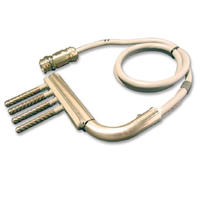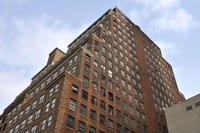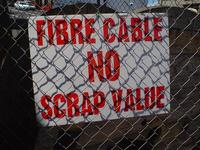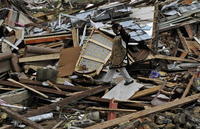-
Shape-memory alloys for earthquake-resistant structures

To improve the performance of structures during earthquakes, researchers have been investigating the use of “smart” materials, such as shape-memory alloys, which can bounce back after experiencing large loads
-
-
Scientists develop new concrete corrosion sensors
Scientists have made a major breakthrough in developing sensors which dramatically improve the ability to spot early warning signs of corrosion in concrete; the sensors will make monitoring the safety of structures such as bridges and vital coastal defenses much more effective
-
-
Smart paint monitors structural safety
An innovative low-cost smart paint that can detect microscopic faults in wind turbines, mines, and bridges before structural damage occurs; the environmentally friendly paint uses nanotechnology to detect movement in large structures, and could shape the future of safety monitoring
-
-
New concrete corrosion sensors developed

Scientists have made a major breakthrough in developing sensors which dramatically improve the ability to spot early warning signs of corrosion in concrete
-
-
Digital images used to prevent bridge failures
A new/old method has been developed to assure the safety of hundreds of truss bridges across the United States; researchers have been testing the use of a thoroughly modern version of an old technique — photographic measurement or “photogrammetry” — to watch the failure of a key bridge component in exquisite detail
-
-
Building earthquake-proof buildings
Researchers in Australia are leading an international project to help identify buildings most vulnerable to earthquakes and the best ways to strengthen them
-
-
Improving pothole repairs
The alarming increase in the number of road potholes in the United Kingdom — an outcome of reduced road maintenance, increasing traffic volumes, heavier loads, and repeated adverse weather — is creating potentially hazardous driving conditions, causing serious concerns to the authorities as well as to the public; engineers are looking foe ways to improve pothole repairs
-
-
Changing bridge fabrication and inspection practices
As today’s engineers investigate the rebuilding of much of the nation’s infrastructure, a lot of which was constructed in the 1950s, they are using much improved materials and analysis tools; a Virginia Tech civil engineer predicts his new work on a fracture control plan for steel bridges promises to change bridge fabrication and inspection practices
-
-
Building codes may underestimate multiple hazard risks
Current building codes consider natural hazards individually — if earthquakes rank as the top threat in a particular area, local codes require buildings to withstand a specified seismic load; if hurricanes or tornadoes are the chief hazard, homes and buildings must be designed to resist loads up to an established maximum wind speed; engineers say that building codes should address multiple hazard scenarios
-
-
Studying the effects of fire on steel structures, nuclear plants
Building fires may reach temperatures of 1,000 degrees Celsius, or more than 1,800 degrees Fahrenheit, and the strength of steel structures drops by about 40 percent when exposed to temperatures exceeding 500 degrees Celsius; scientists study precisely what happens to the connections between a floor’s steel beams and the building columns when these connections are exposed to intense heat
-
-
New York's older brick buildings vulnerable

To get a better idea of just how much damage even a moderate earthquake would cause to unreinforced masonry buildings, earthquae-engineering researchers are reconstructing brick walls like those in New York City buildings that are approximately 100 years old
-
-
Virginia quake highlights overlooked danger: decrepit dams
Tuesday’s Virginia earthquake raised fears that a Fukushima scenario would unfold somewhere on the East Coast, but experts say that earthquake pose a much greater threat: breaching decrepit dams; of the 85,000 dams in the United States, 4,000 are seriously unsafe or deficient — and of those, 1,800 are located in areas where a breach would cause grave damage to life and property
-
-
DHS warns copper thefts on the rise

DHS officials warn that copper thefts from critical infrastructure and key resource sectors in the United States are on the rise; in March, a Port of Houston security guard was arrested for giving his friends and families access to the port, where they allegedly stole more than 22,000 pounds of copper
-
-
Calls for more stringent standards in wake of increasing storm damage

Researchers from a team funded by the National Science Foundation have examined some of last spring’s massive tornado damage and conclude in a new report that more intensive engineering design and more rigorous, localized construction and inspection standards are needed to reduce property damage and loss of life
-
-
Improved engineering to protect structures on storm’s edge

In the wake of the horrendous tornadoes that delivered massive destruction to Alabama in April, University of Alabama engineers have analyzed building structures and design codes to recommend an approach to safer and stronger buildings going forward
-
- All
- Regional
- Water
- Biometrics
- Borders/Immig
- Business
- Cybersecurity
- Detection
- Disasters
- Government
- Infrastructure
- International
- Public health
- Public Safety
- Communication interoperabillity
- Emergency services
- Emergency medical services
- Fire
- First response
- IEDs
- Law Enforcement
- Law Enforcement Technology
- Military technology
- Nonlethal weapons
- Nuclear weapons
- Personal protection equipment
- Police
- Notification /alert systems
- Situational awareness
- Weapons systems
- Sci-Tech
- Sector Reports
- Surveillance
- Transportation
Advertising & Marketing: advertise@newswirepubs.com
Editorial: editor@newswirepubs.com
General: info@newswirepubs.com
2010-2011 © News Wire Publications, LLC News Wire Publications, LLC
220 Old Country Road | Suite 200 | Mineola | New York | 11501
Permissions and Policies
Editorial: editor@newswirepubs.com
General: info@newswirepubs.com
2010-2011 © News Wire Publications, LLC News Wire Publications, LLC
220 Old Country Road | Suite 200 | Mineola | New York | 11501
Permissions and Policies
